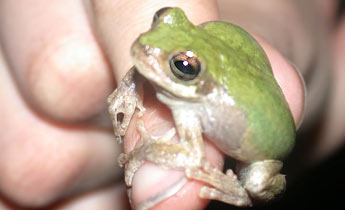Bird-voiced Treefrog (Hyla avivoca)
Bird-voiced Treefrog (Hyla avivoca)



Description: A small treefrog with variable dorsal coloration, usually mottled gray but capable of changing to brownish or green depending on temperature and activity. A pale square mark is present beneath the eye, similar to the larger Gray Treefrog (Dryophytes versicolor). The concealed thigh coloration most reliably distinguishes the two species: bird-voiced treefrogs have greenish-yellow flash marks, compared to the more orange tones of the gray treefrog.
Range and Habitat: Occurs in parts of Louisiana, western Tennessee, southern central Alabama, most of the Florida Panhandle, parts of central and southern Georgia, and a narrow range into South Carolina. Closely associated with river swamps dominated by bald cypress (Taxodium distichum), tupelo gum (Nyssa aquatica), and adjacent sloughs and backwaters. Breeding sites typically include brushy or densely vegetated areas near open water. Individuals are often found high in trees outside of breeding, though they may descend into dense understory vegetation.
Habits: Primarily nocturnal and most active in late spring and summer. Males begin calling once temperatures exceed ~70°F, sometimes even during the day. Breeding occurs in swampy backwaters and vegetated margins of rivers. Amplexus usually occurs in shrubs along the water’s edge; females deposit 400–800 eggs in small clusters that adhere to the substrate. Eggs hatch within 2 days, and metamorphosis occurs in about 4 weeks.
Call: A birdlike series of high-pitched, whistled notes given in rapid succession. The cadence has been compared to the drumming of a pileated woodpecker.
Conservation Status: The status is poorly defined due to limited study, but like many amphibians, the species is considered vulnerable to habitat loss, wetland alteration, and urbanization. It is locally common in suitable cypress–tupelo swamp habitats.
